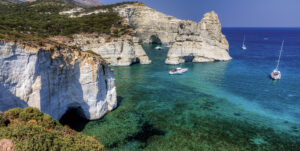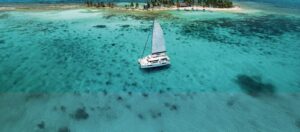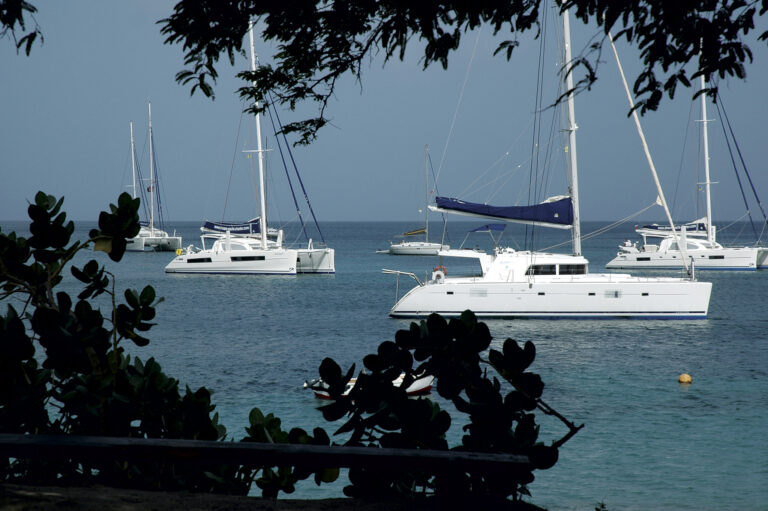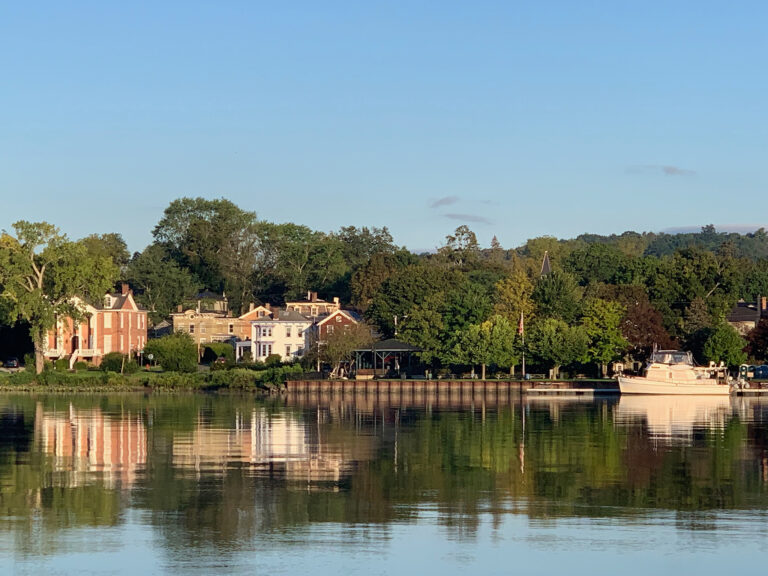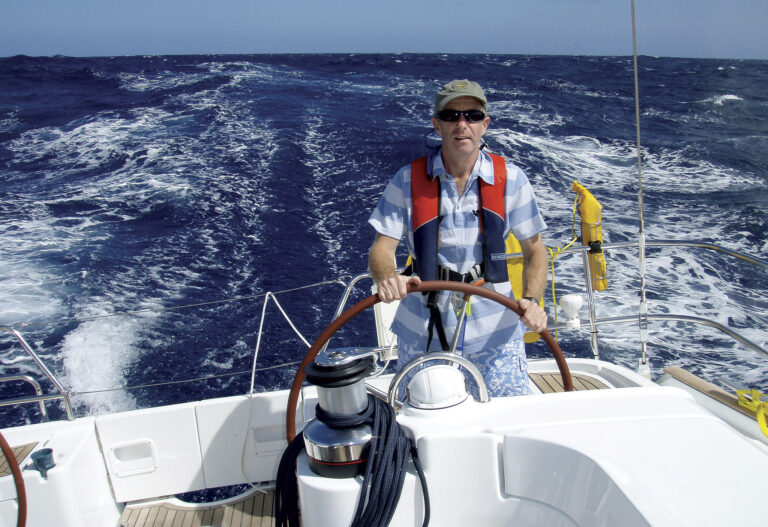No matter how many sea miles you clock up or how many days a year you manage to spend on the water, some sailing experiences stick in the mind more than others; those days when boat, crew, wind, water and weather all seem to be working together in perfect harmony. When I look back on my best days on the water, the one that’s always near the front of my mind is a 45-mile daysail from St. Vincent to Carriacou some 10 years ago. It was just about the best Caribbean sailing you could ask for—bombing along at 8 and 9 and sometimes 10 knots on a beam reach, the sun burning down out of a sky so blue it hurt your eyes, startled flying fish skipping across the wavetops. The newbie on board hogged the wheel for almost the whole six hours. None of us wanted to stop when we rounded up off Carriacou to drop the mainsail.
Naturally enough I was hoping for a repeat performance last January, when I flew into St. Vincent for the first time in a decade to pick up a Bavaria 45 from the new Horizon Yacht Charters base in the Blue Lagoon, on St. Vincent’s southern tip. If there’s a better jumping-off point for an island adventure, I’ve yet to see it. Once you’ve negotiated the narrow, unmarked pass through the Blue Lagoon reef—or rather, let one of the Horizon crew negotiate it for you—the prettiest group of islands and cays in the entire Caribbean unfolds in front of you, 32 of them all up.
I’d prepared for this charter by not by perusing charts but by reading Ferenc Máté’s excellent coffee-table book Islands of Eden, a photographic ode to this nation of islands. It’s in no way a pilot book or even a guide book, but its lush photography exerts a powerful lure, especially if you’re reading it in the biting cold of January in Boston. “In the Grenadines you can have a new life every day,” Máté writes. “No island is more than a three-hour sail from another, the trade winds blow at a steady 15 knots, and the harbors, while often small, yield either utter solitude or good restaurants and bars. And to a sailor all that makes for Paradise.” Amen to that, brother Máté. Paradise, here we come.
An easy 90-minute reach to Bequia, where we were to collect a third shipmate, was the perfect intro to a week’s cruise. Admiralty Bay was crowded, but Horizon base manager James Pascall had recommended the services of a boat boy whose moorings he trusted and who set us up on a ball close to town. This encounter, as were most of our others with members of this service industry, was brief and businesslike. Since cruisers and charterers are their bread and butter it doesn’t pay the boat boys to make nuisances of themselves, although I’m sure some do. I would advise you to ascertain in advance the price of the services or goods they are procuring for you—and in which currency, the Eastern Caribbean (EC) dollar or the U.S. dollar—or you may end up, as we did, with a US$10 loaf of banana bread. And I don’t even like banana bread…
Bequia is worth a day of your time. Port Elizabeth’s delights can be covered in the space of half an hour, after which the long walk over the hill to Friendship Bay on the Atlantic side is worth the huffing and puffing in the hot afternoon sun (tip: get a cab back). Back in Port Elizabeth, the waterfront restaurants are linked by a boardwalk that makes for a pleasant evening stroll as you try to pick out somewhere to eat. Dining out isn’t cheap; expect to pay what you would at a waterfront eatery Stateside. But if you look hard enough you can find some downscale places serving perfectly cooked local cuisine at reasonable prices—and you can buy local produce from one of the friendly Rastafarians at the market. Groceries aren’t cheap, but hey, at least you’re supporting the local economy.
Over breakfast the next morning we considered our options. Mustique? Nope, the young British royals William and Kate were holidaying there, which meant a large and protective official presence, and in any case you can no longer anchor there—you have to pick up a mooring for $75, though in fairness that covers three nights, should you not have had enough of celeb-spotting after day one. No, Saltwhistle Bay on Mayreau it would be. We unrolled Namaste’s sails—yes, a charter boat with not only an inmast furling mainsail, but electric genoa winches, what bliss—and trimmed them for a glorious reach down to Mayreau, gateway to the Tobago Cays.
I had fond memories of Saltwhistle Bay from my previous visit. We had been one of a half-dozen boats in the anchorage (admittedly, at the peak of hurricane season) and thoroughly enjoyed floating around in the limpid waters and lolling about on the picture-postcard white-sand beach with its fringe of palm trees. Imagine my shock when we rounded the point to see what looked like wall-to-wall boats, most of them charter cats, some anchored, others hanging off some decidedly suspect-looking (and, I think, illegal) moorings set down by the boat boys. That’s the problem with must-see destinations—everyone wants to see them. After half an hour watching neighbors swinging perilously close it became clear there would be no relaxing here, so we hauled up the hook and motored around the corner to the island’s other harbor, where we found good holding in 10ft of water, close to shore and a hundred yards from the nearest boats.
A steep walk up the hill to the village revealed, thankfully, that Mayreau’s quiet charm remained unadulterated by the teeming masses anchored below. It was pretty much as I remembered it from 10 years before, just as laid-back and unpretentious, with maybe a new restaurant or two, and the same multi-billion-dollar view of the multicolored waters of the Tobago Cays from the little church atop the hill. We dined on conch fritters and Carib beer in a quiet restaurant overlooking the Caribbean Sea as the setting sun shot bolts of gold through towering clouds. Sublime.
Enough words have been written about the Tobago Cays to fill a library. I will not add to them save to say that here is another item to place near the top of your sailing bucket list. We sailed back around Mayreau and threaded the needle between Horseshoe reef and the small islets of Petit Rameau and Petit Bateau. In poor visibility and high winds this could be a bit of a puckering experience, but with the sun high and the water color telegraphing the depth it was not a problem. There were maybe 30 or 40 other boats around us, but we had no trouble finding a clear spot. Our run of perfect weather continued as the cooling trades sighed in the rig and we alternated snorkeling on the reef with napping in the cockpit and imbibing cool Caribs. Again, sublime.
After that, any other anchorage would have had a hard act to follow. We called in at Union Island for provisions, and I found the small town of Clifton had become positively gentrified over the last 10 years. The circle of local-produce stores was the same, but there were now boutiques in the main street, more restaurants and even a mini-mall, island style. People were friendlier than I recalled, too, perhaps because of the increased prosperity. The anchorage was too open for my liking, so we scooted round the corner and found good protection and holding behind Frigate Island, near the ruins of what was once an ambitious marina project—obviously a bit too ambitious. A dinghy ride ashore to the town of Ashton for ice and provisions provided another snapshot of island life.
A gentle meander across the Martinique Channel the next morning brought us to the anchorage at Petit Martinique, which I had long wanted to visit, mainly because it was once a smuggler’s paradise. It’s part of the Grenada Grenadines, along with Grenada and Carriacou, but with no officials in sight we felt no need to clear in for the two hours or so we spent exploring ashore. There, we met a group of local lads preparing some brightly painted wooden sloops for the upcoming traditional boat races.
Not trusting the holding in the open roadstead, we moved around the reef and back into SVG territory, namely Petit St. Vincent, where the 45lb Delta sank its lone fang into the pure white sand 6ft below the keel. With 80ft of chain out we felt justified in going ashore for rum drinks at the swanky resort that occupies most of the island, and they worked so well we stayed for dinner too.
The last couple of days of a sailing vacation are always the worst, in that you feel the weight of a deadline and the knowledge that the world, or in this case the Grenadines, are no longer your oyster. Fortunately the wind was fair and our boat was fast, so we opted to sail back to Bequia in one day, with a lunch stop at Canouan along the way. And yes, the sailing was great, the big Bavaria showing off its Bruce Farr pedigree and reeling off 8 or so nautical miles each hour.
That last night, recapping the week over Hairoun beer and some excellent rotis at a beachside rum shack-cum-restaurant surrounded by cost-savvy cruisers, we looked back at a solid week’s sailing in an ideal cruising ground. Not as easy as the nursery slope sailing in the BVI, to be sure, but all the spicier for that. I don’t think I’ll wait another 10 years before I return. Perhaps a one-way charter from St. Vincent down to Horizon’s Grenada base next time? That bucket list doesn’t get any shorter…
We chartered our Bavaria 45 Cruiser from Horizon Yacht Charters (horizonyachtcharters.com) at the Blue Lagoon in St. Vincent. Other charter companies serving the area are Barefoot Yacht Charters (barefootyachts.com), Sunsail (sunsail.com) and The Moorings (moorings.com) from their St. Lucia base or Grenada bases, Dream Yacht Charter (dreamyachtcharter.com) from Grenada.
Getting there: You can fly direct to St. Vincent from Miami, New York, Atlanta and Charlotte, or connect via St. Lucia or Barbados. The sailing is good year-round and the Grenadines are rarely affected by hurricanes.
Currency: The Eastern Caribbean dollar is the local currency, but the U.S. dollar is welcomed everywhere. At press time, $1EC was worth US$0.37.
October 2015



